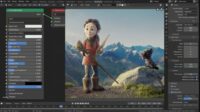
From Concept to Creation: Understanding 3D Modeling Software
Introduction
3D modeling software has revolutionized the way objects are designed, visualized, and manufactured. From intricate architectural renderings to cutting-edge product prototypes, 3D modeling has become an indispensable tool across a wide range of industries. This article delves into the intricacies of 3D modeling software, exploring its capabilities, types, and applications, empowering readers with a comprehensive understanding of this transformative technology.
Understanding the Fundamentals of 3D Modeling
3D modeling involves creating three-dimensional representations of objects using computer software. Unlike 2D drawings, which are constrained to flat planes, 3D models allow for the manipulation and visualization of objects from all angles, providing a highly realistic and interactive experience.
The process of 3D modeling typically involves several key steps:
- Modeling: Using various tools and techniques, such as polygonal modeling, subdivision surfaces, and NURBS, designers create the basic shape and form of the object.
- Texturing: The model is given color, surface properties, and details to enhance its visual realism.
- Lighting: The model is illuminated to create realistic shadows and highlights, simulating the effects of light in real life.
- Rendering: The final image or animation is generated, showcasing the model in all its glory.
Types of 3D Modeling Software
A vast array of 3D modeling software programs exists, each with its strengths and capabilities tailored to specific industries and use cases. Some of the most popular types include:
- Computer-Aided Design (CAD) Software: Used primarily in engineering and manufacturing, CAD software enables precise modeling of mechanical parts, assemblies, and architectural structures.
- Organic Modeling Software: Designed for creating complex organic shapes, such as characters, creatures, and environments, often used in film, animation, and video game development.
- Polygon Modeling Software: Focuses on creating models using polygons, a series of flat surfaces that can be manipulated to form complex shapes. Widely used in game development, industrial design, and 3D printing.
- Subdivision Modeling Software: Utilizes subdivision surfaces, a smoother and more organic alternative to polygonal modeling, often used in character design and animation.
Applications of 3D Modeling
The applications of 3D modeling extend far beyond its initial use in the entertainment industry. Today, it has become an essential tool in various industries, including:
- Architecture and Engineering: Creating realistic renderings and models for building design, urban planning, and infrastructure projects.
- Product Design and Development: Visualizing and prototyping products before manufacturing, reducing time and costs associated with physical prototypes.
- Medical Imaging: Constructing 3D models from medical scans for diagnostic purposes, surgical planning, and patient education.
- Education and Training: Providing students and professionals with interactive and immersive learning experiences in fields such as anatomy, engineering, and design.
Choosing the Right 3D Modeling Software
Selecting the right 3D modeling software for your specific needs is crucial. Consider the following factors:
- Skill Level: Software complexity varies widely. Choose software that aligns with your experience level and the complexity of your projects.
- Industry Requirements: Different industries may require specific software that meets their unique standards and workflows.
- Features and Functionality: Assess the software’s features, such as modeling tools, rendering capabilities, and support for specific file formats.
- Compatibility: Ensure the software is compatible with other software you use, such as CAD or animation programs.
- Cost: Software prices range from free to thousands of dollars. Determine a budget that aligns with your needs and resources.
Conclusion
3D modeling software has become an indispensable tool for designers, engineers, and artists worldwide, empowering them to create realistic and immersive digital representations of objects. Understanding the fundamentals of 3D modeling, the different types of software available, and their


